The Intel Lakefield Deep Dive: Everything To Know About the First x86 Hybrid CPU
by Dr. Ian Cutress on July 2, 2020 9:00 AM ESTLakefield CPUs and Devices Coming To Market
With Intel teasing Lakefield from late 2018 and stating 2020 availability, naturally we had been expecting an announcement at some point this year, and in early June the company officially announced the two processors that would be coming to the Lakefield family. Technically this is four SKUs, which I’ll get on to.
Both the parts feature ‘Core i5/i3’ branding, however they will not fall into a traditional Core generation naming. So where Skylake was 6th Gen Core, Comet Lake was 10th Gen Core, these are just ‘Intel Core Processors with Intel Hybrid Technology’. Rolls off the tongue, doesn’t it.
Both CPUs are the same silicon underneath, just with different core frequencies and GPU configurations with the Core i3 having it partly disabled.
| Intel Lakefield Processors | ||||||||
| AnandTech | Cores | Base Freq |
1C Turbo |
nT Turbo |
Gen11 IGP |
IGP Freq |
DRAM LP4 |
TDP |
| i5-L16G7 | 1+4 | 1400 | 3000 | 1800 | 64 EUs | 500 | 4267 | 7 W |
| i3-L13G4 | 1+4 | 800 | 2800 | 1300 | 48 EUs | 500 | 4267 | 7 W |
Intel confirmed that the base frequency and all-core turbo values are unified frequencies across all the cores, while the single core turbo applies to the Sunny Cove core. Support for LPDDR4X-4267 is given for both processors, and is a frequency notch above the support found in Ice Lake. The graphics is wide and slow, running at only 500 MHz, and both CPUs have a TDP of 7W. The amount of PoP memory does not affect the TDP.
However, it’s the PoP memory that will provide each one of these processors with two variants. The memory for Lakefield is being provided by a third party (Intel won’t say who, so I guess we’ll find out when we put the CPU in acid), and assembly is done by Intel. Intel will offer both processors in 4 GB and 8 GB configurations, running at a maximum memory bandwidth of 34 GB/s, indicative of dual 16-bit memory controllers. So despite the frequency of the memory being higher than Ice Lake, Ice Lake can address 4x16-bit memory controllers, giving an overall higher memory bandwidth.
Intel will debut these two SKUs in its first generation of Lakefield. Even those these CPUs are a 1+4 configuration, operating mainly in a 0+4 as mentioned on the previous pages, Intel is placing them in the premium market spaces due to the increased complexity of construction but also on the basis of the low idle power. Intel claims a 2-3 mW idle power (initially said 2 mW, then said 3 mW, then settled on 2.6 mW, depending on who you ask) while in connected standby modes. This will help any systems using them achieve long periods of sleep modes without needing to worry about casual drain.
As a result, these CPUs will find homes in premium, always-connected laptops, such as the Samsung Galaxy Book S expected in markets this month, the Lenovo ThinkPad X1 Fold, coming later this year, and in the Microsoft Surface Book Neo.
Samsung Galaxy Book S
As per our announcement piece:
First teased by Samsung late last year, the Lakefield-based version of the laptop is set to join their existing Qualcomm 8cx-based model, swapping out the Arm SoC for x86, providing a very interesting point of competition if we’re able to compare the two in the same chassis. The Intel Galaxy Book S will be the first device to ship with Lakefield, putting the new processor to the test in seeing if Intel can match the kind of all-day battery life that the existing Galaxy Book S is known for.
Taking a look at the specifications, the Intel-based version of the Galaxy Book S is a spitting image of the Qualcomm version. Samsung appears to be using the same chassis here, so the 13.3-inch laptop retains the same dimensions as the current model, as well as the same two USB-C ports. The battery capacities are identical as well at 42 Wh, and I expect that the Intel model is also using the same 1080p LCD. Curiously though, the Intel model does end up being ever so lighter than the Qualcomm model – Samsung puts the former at 950g, 10g lighter than the 960g Qualcomm model.
| Samsung Galaxy Book S Family | ||
| Galaxy Book S (Intel) | Galaxy Book S (Qualcomm) | |
| CPU | Intel Core with Hybrid Technology 1x Sunny Cove (Core) 4x Tremont (Atom) |
Qualcomm Snapdragon 8cx 4x Kryo 495 Gold @ 2.84 GHz 4x Kryo 495 Silver @ 1.8 GHz |
| GPU | Intel UHD Graphics | Adreno 680 |
| Display | 13.3 Inch, 1920×1080 Full HD Touchscreen |
|
| Memory | 8 GB LPDDR4X | |
| Storage | 256/512 GB eUFS + microSD Card Slot |
256/512 GB + microSD Card Slot |
| Networking | Wi-Fi 6 (802.11ax) BT 5.0 |
Wi-Fi 5 (802.11ac) BT 5.0 |
| Modem | Discrete LTE Cat 16 |
Integrated Qualcomm X20 LTE Cat 18 |
| Battery | 42 Wh | |
| Ports | 2 x USB-C 1 x 3.5 mm (phono/mic) |
|
| Dimensions | 305.2 x 203.2 x 11.8 mm | |
| Weight (Approx) | 950g | 960g |
| Price (USD) | N/A | Starts at $999 |
As for memory and storage, because the memory is part of the Lakefield package, Samsung is only offering a single 8GB configuration here. Unfortunately Samsung’s spec sheet doesn’t list memory frequencies, so we’ll have to wait and see what Intel has Lakefield’s memory clocked at. Meanwhile Samsung provides the storage, using 256GB or 512GB of their eUFS flash memory. To my knowledge this is the first x86 laptop to ship with eUFS, reflecting the mobile roots of the devices Intel is targeting with Lakefield. Further storage expansion is then available through a microSD card slot.
One specification that’s notably missing from Samsung’s announcement is the expected battery life of the Intel-based model, and this is perhaps going to be the most interesting aspect of Lakefield. Intel has worked very hard to get their idle power consumption down to be able to match what Qualcomm has achieved with the 8cx, with the company claiming that Lakefield draws just ~2-3mW at idle. At the same time, however, Lakefield lacks an integrated modem, and as a result Samsung is relying on an Intel Cat 16 external modem here. So in the battle of the Galaxy Books, Qualcomm will have the advantage in regards to requiring fewer chips.
As for other wireless connectivity, the new Intel model will ship with a 2x2 Wi-Fi 6 radio, giving it an edge there over the Qualcomm model with Wi-Fi 5. And both models ship with Bluetooth 5.0 support.
Rounding out the package, the Intel-based Galaxy Book S has a 720p webcam, a built-in microphone as well as Dolby Atmos-badged stereo speakers co-designed with AKG. The laptop also has a Windows Hello-compatible fingerprint reader. Price is currently unknown.
Lenovo ThinkPad X1 Fold
From our news announcement coverage:
The new Fold is a true high-end Thinkpad, with a flexible 13.3-inch OLED display split across the two halves of the design, essentially becoming the size of a notepad when folded. This means that when unfolded, it offers 2x more screen real estate than a Samsung foldable smartphone. The construction of the foldable display includes metal frames and supports combined with carbon fiber plates. The hinge mechanism claims to provide friction free folding, but also allows for rigid support at a variety of angles when unfolded like a standard clamshell.
When folded, the device is just over an inch thick (27.8 mm) at its widest point, but when unfolded becomes only 7.8 mm thick, or 11.5 mm with the included cover. The reason that the folded dimension is more than 2x the unfolded is because there will be a slight ridge on the hinge where the fold is, so the display isn’t crisply folded.
Inside the unit beats the heart of a properly built laptop. We’ve got one of the first new outings for Intel’s Lakefield processor, featuring 1 big Sunny Cove core and 4 smaller Tremont Atom cores, combined with Intel’s Gen11 HD Graphics (the ones that come with Ice Lake, although it doesn’t mention frequencies or EUs). Memory is a full 8 GB of LPDDR4X-2133 with storage provided by a standard M.2 2242 NVMe drive, although Lenovo will offer variants up to 1 TB. There’s an inbuilt 5 MP camera, and the battery is a proper 50 Wh, good for 11+ hours according to Lenovo.
The exact specifications on the display is a 13.3-inch flexible OLED with a 2048x1536 resolution, with brightness up to 300 nits and color gamut support up to 95% of DCI-P3. Touch is also implemented.
For IO, the device has two USB Type-C ports (one USB 3.1, one USB 3.2), and a Displayport over Type-C port for external displays. There is also a SIM slot in order to use the onboard modem. Lenovo lists the modem as 4G/5G, although doesn’t state which modem this is – it’s likely to be Qualcomm’s X55 at this point. The device also supports 802.11ax and BT5.0.
The price according to Lenovo is $2499 for the 1 TB model. All units will come with an Active Pen and an external keyboard in the box, and altogether the unit weighs 999g / 2.2 lbs (cover included). The keyboard can be off the notebook, or placed on one half of the screen:
The Lenovo ThinkPad X1 Fold looks like a crazy device that I’d love to test. Lenovo has a tentative date of ‘Mid 2020’ for the product, which will likely depend on display availability as well as Intel’s production of Lakefield processors.
Microsoft Surface Book Neo
Less is known about the Surface Book Neo. It was presented by Microsoft at an event in October 2019, featuring dual 9-inch screens and a fully rotatable hinge, and according to Microsoft’s website should be available by the end of the Holiday 2020 season.
The Neo is a true dual screen device, rather than something foldable, but will still use the external keyboard. We expect some form of pen support, and it should be running Windows 10X, a special build of Windows built for multi-screen devices like this one. However, it has been reported that Windows 10X has been delayed until next year due to the additional complexities of working from home during the pandemic as well as a focus more on single screen devices.


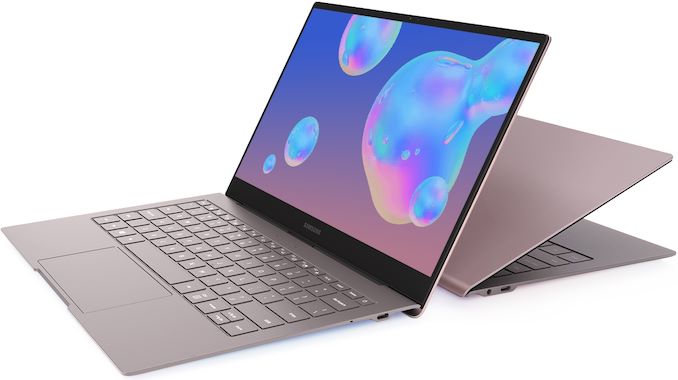
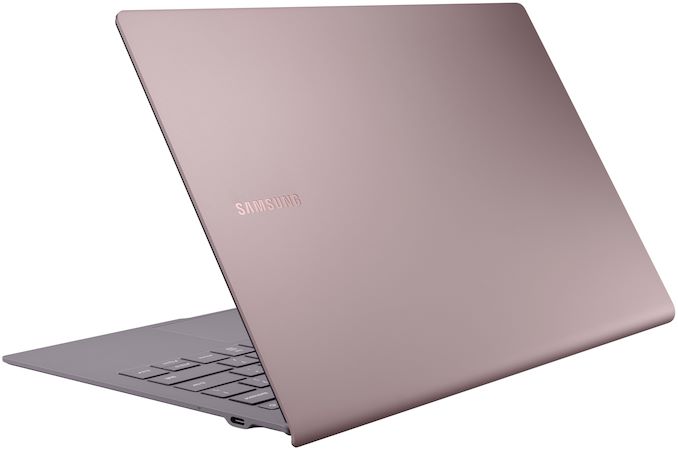
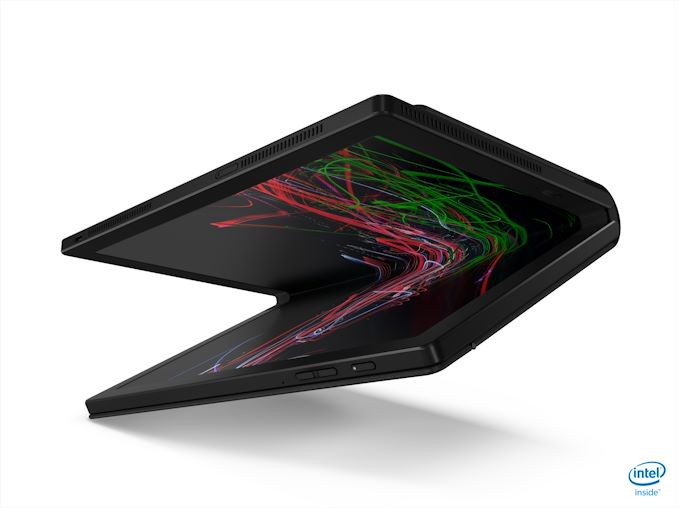
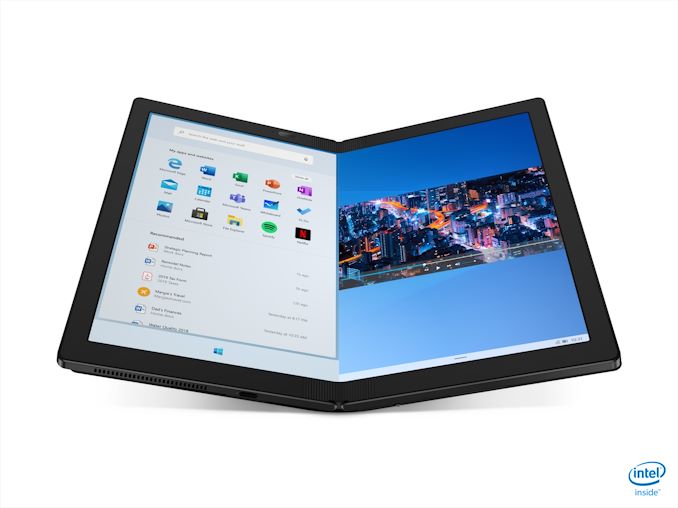
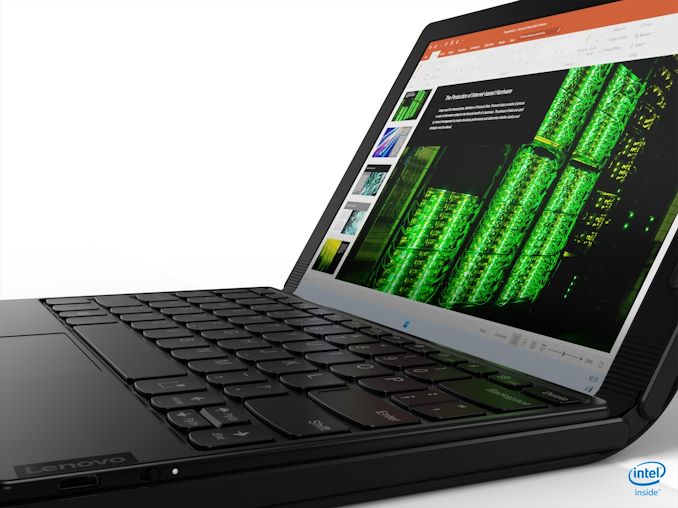
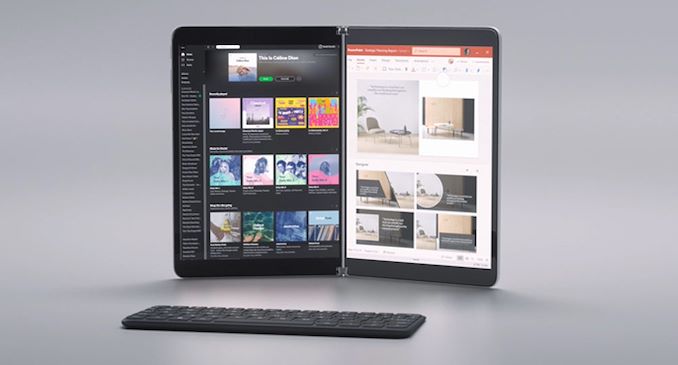








221 Comments
View All Comments
Valantar - Sunday, July 5, 2020 - link
Uhm, I have to ask, did you write this comment eight months ago? AMD has been kicking Intel's butt in 15W laptops since the first Renoir laptops hit the streets. While that did take a while after the initial presentation, their advantage is nonetheless significant both in performance and power draw.serendip - Monday, July 6, 2020 - link
AMD doesn't have anything in the 5W TDP range. Not yet, anyway. The problem is that Lakefield brings middling performance at a high price. Intel already has 5W and 4W parts, check out the Pentium 4425Y and m3-8100Y in the Surface Go 2. Those chips are much cheaper and easier to fab than Lakefield and they bring equal or higher performance.Kangal - Tuesday, July 7, 2020 - link
The best sku chipset that AMD makes in the "15W bracket" is the 4800U. However, that's with the TDP-down as it's not a proper 15W part. Plus, there are no laptops with that combination yet. The Lenovo Yoga Slim7 has the chipset, but it is at the 25W bracket, and apparently that goes much higher during use when possible.So no, AMD isn't quite kicking Intel's butt in the Ultrabook segment yet. Maybe in 6 months, when yields improve and more vendors join. But for now, Intel is still the dominant force in the Thin & Light segment. AMD they're killing it at the Regular Laptop market, the Entire Desktop Market, the Server market, and the Console market. However, ARM is pretty much going to take over the Server Market now that the big companies are moving that way, and since Linux drivers have matured on ARMv8_64. The laptop segment is safe for now, but the new Macs might cause other vendors to think beyond Windows, or think beyond x86. The Console segment and Desktop segments are safe for now (and for at least this decade).
Spunjji - Friday, July 10, 2020 - link
That's an arbitrary distinction if ever I saw one. By that definition, Ice Lake is a 28W part operating in "TDP down" to 15W.AMD could conceivably laser 4 cores and 60% of the GPU off a Renoir chip, drop the clocks and end up with a "5W" part not dissimilar to Intel's M3 series. It wouldn't make any sense for them to do so, though, because they can't make enough chips as it is and it wouldn't really buy them any meaningful market share.
Kangal - Friday, July 10, 2020 - link
I didn't discount the 4800U at all. I merely stated the fact that it is, in fact, a 25W chipset and it can operate at 15W with TDP-down. I'm not sure you quite understand this tier system.But anyways, my point was that AMD's best 15W option is the 4800U, but we don't know how it actually performs because there are no devices out there. From what we can speculate, it should be very competitive, but Intel really has championed the Ultrabook market in the last decade. So for all intents and purposes, Intel is probably still ahead here by a hair, yet they could've had a larger lead if they implemented the above design I tried to explain. Too bad. AMD will humiliate/supersede them completely in a year or two at this pace.
Spunjji - Monday, July 6, 2020 - link
"And AMD would struggle to fit those technologies into a 8-core laptop processor, so there would be no threat from above."Boy, you really need to keep up with the news...
Kangal - Tuesday, July 7, 2020 - link
No, you didn't read that correctly.AMD doesn't have any 8-core processor on their 16nm/14nm/12nm node, that is, confined to the thermal profile of a laptop. I was saying Intel needed to release the processor that I outlined, and release it years ago. And if they did that, then their only competition would be Renoir/Ryzen-4000, and even then AMD would lose on the low-voltage (Ultrabook) market and win on the regular (Laptop) market.
See the above comment by serendip. AMD is working on having lower and lower voltage chips. Their lowest power one I think is still the V1605B embedded chip. But right now, that small company is really stretched thin. They're working on Servers, on HDD optimisations, on making GPUs, on optimising GPUs, on making console processors, on desktops, laptops, and a few other budget options.
By the time AMD actually properly polishes the driverset for laptops/battery drain, it's going to be another year. But hopefully, on the next set of chips they update the graphics (from Vega to RDNA). It's possible they might ditch the monolithic design of their mobile chips, and shift those over to a chiplet design as well. This will take a hit to performance, and to efficiency... but on the bright side it should mean even cheaper processors to vendors and consumers-alike.
Spunjji - Friday, July 10, 2020 - link
I think I understand now, but the phrasing was confusing!eastcoast_pete - Thursday, July 2, 2020 - link
It's beyond embarrassing, it's borderline idiotic. Intel's "performance" cores have one unique differentiator going for them, and that is the ability to execute AVX, especially AVX2 and AVX512 instructions. Doing what they did means they basically gelded their own big core, and this gelding won't win any performance crowns.I sort of get why it's hard to have a scheduler trying to work with cores that have different capabilities, but is it really impossible to have one that makes it a hard and fast rule that if an AVX instruction is called for, the big core gets fired up? Now, I am not able to program one of these myself, but, as a user, I would rather pay a little power consumption penalty and have a real Sunny Cove-like large core than an overgrown Atom as the "performance" core. Big mistake.
brantron - Thursday, July 2, 2020 - link
The trouble with AVX on the Sunny Cove core is it will still only be one core.So add another, and call it...Ice Lake Y? Wait a minute... :p
After more than a decade, Atom for PC still looks like a square peg in a round hole.